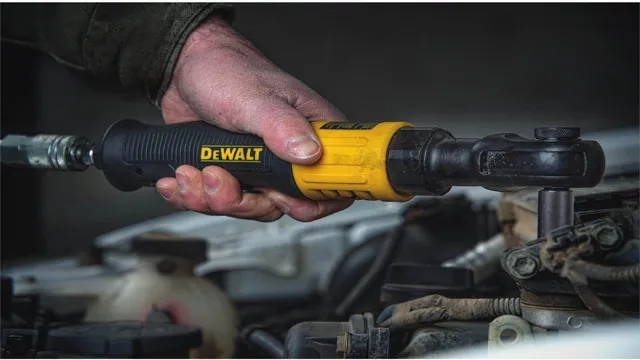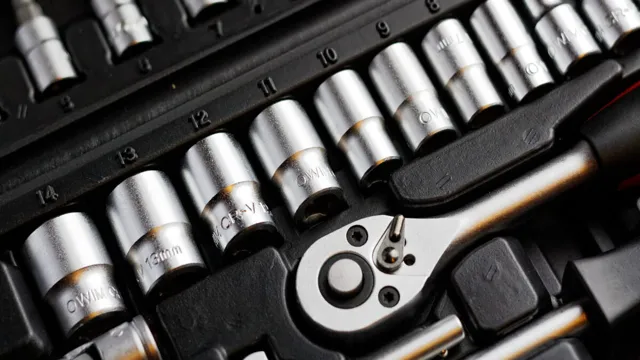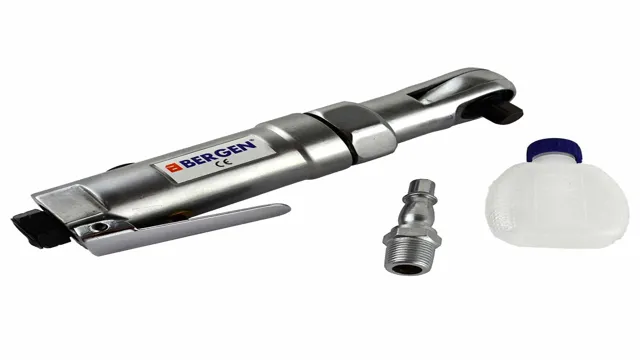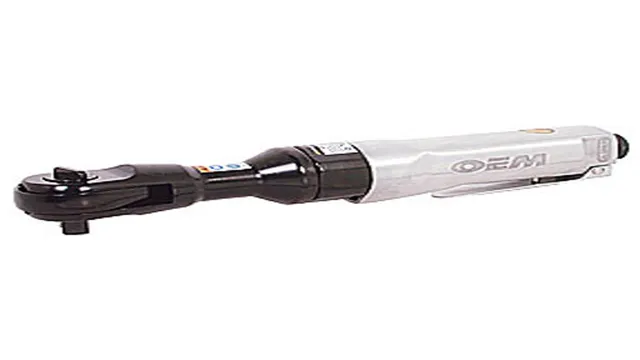How to Use Air Ratchet for Efficient and Smooth Operations
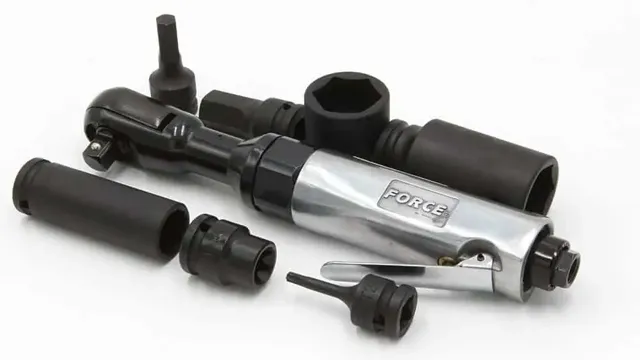
If you have ever taken on any kind of DIY or automotive project, you know how frustrating it can be to get the right tool for the job. One tool that you may need is an air ratchet, especially if you’re working on bolts or screws and want to get the job done quickly and efficiently. But how do you use an air ratchet? If you’re a beginner, this guide will help you understand everything you need to know about using an air ratchet, including how it works, what features to look for, and how to use it safely and effectively.
With this guide, you’ll be able to take on any project with confidence!
Understanding an Air Ratchet
Have you ever found yourself in a situation where you need to loosen or tighten a bolt or nut but can’t seem to do it manually? This is where an air ratchet comes in handy. An air ratchet is a type of pneumatic tool that uses compressed air to operate. Using an air ratchet to loosen or tighten bolts can save you time and energy, but it’s important to know how to use it properly.
First, connect the air hose to the ratchet and adjust the pressure to the recommended level. Next, attach the appropriate socket to the ratchet and place it over the bolt or nut. Pull the trigger and allow the ratchet to do the work for you.
Be careful not to over-torque or strip the bolt/nut. With a little practice, using an air ratchet can become second nature and make your DIY projects or mechanical tasks much easier.
Introduction to an Air Ratchet
An air ratchet is a powerful tool that every mechanic should have in their arsenal. This versatile tool is designed to make quick work of tough nuts and bolts, saving you time and effort. Understanding an air ratchet is crucial if you want to make the most of this tool.
An air ratchet works by using compressed air to power the tool’s motor, which in turn drives the ratchet mechanism. This allows you to turn a nut or bolt with ease, without having to apply as much force as you would with a traditional ratchet. The great thing about air ratchets is that they are incredibly fast, making them perfect for jobs where speed is essential.
When using an air ratchet, it’s important to keep in mind that it can deliver a lot of torque, so it’s important to use caution and make sure you have a good grip on the tool. With a little bit of practice, however, you’ll be able to use an air ratchet like a pro and tackle any job with ease.
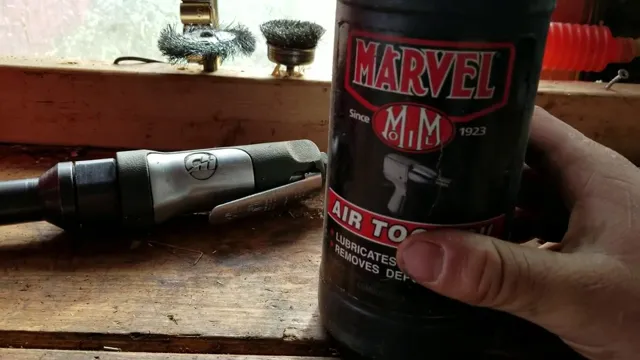
Parts of an Air Ratchet
Air ratchets are essential tools for both professional mechanics and DIY enthusiasts. However, understanding how an air ratchet works can be challenging, especially when trying to identify its distinct parts. Thankfully, identifying the parts of an air ratchet is relatively easy once you get the hang of it.
The key pieces include the ratchet head, motor, exhaust, trigger, grip, and air intake. The ratchet head houses the anvil, which is responsible for engaging sockets and turning bolts. The motor powers the ratchet head and is fueled by air compression from an air compressor.
The exhaust releases air and prevents overheating. You activate the ratchet by pulling the trigger and control the speed by holding the grip. Additionally, the air intake brings in air from the compressor to power the ratchet’s motor.
Understanding the role each component plays in the air ratchet’s operation is crucial in choosing the right tool for the job and ensuring its optimal performance.
Choosing the Right Socket
When it comes to using an air ratchet, choosing the right socket is crucial to getting the job done correctly and efficiently. The first step is to identify the size of the bolt or nut that needs to be loosened or tightened. Then, select a socket that matches that size.
It’s important to ensure that the socket fits snugly over the bolt or nut to prevent slipping or rounding. Using the wrong size socket can also cause damage to both the tool and the bolt or nut. Additionally, it’s important to pay attention to the type of socket material being used.
Chrome sockets are durable and affordable, while impact sockets are designed to withstand the high torque generated by air ratchets without breaking or shattering. By selecting the appropriate socket for the job, you can ensure a smoother and more successful air ratcheting experience.
Determine the Size and Type
When it comes to selecting the right socket for your project, the size and type play a crucial role. Before making a final decision, you need to assess the specific requirements of your project and determine the appropriate socket size and type accordingly. The socket size is determined by the size of the bolt head or nut that you are working with.
The most common socket sizes are 1/4-inch, 3/8-inch, 1/2-inch, and 3/4-inch. You must choose the socket size that fits the bolt head or nut securely to avoid slippage and rounding. The type of socket you choose will depend on the nature of your project.
A standard socket is a good option for basic applications. Deep sockets, on the other hand, are ideal for hard-to-reach places where the bolt head or nut is deeply set. Impact sockets, meanwhile, have been specifically designed to withstand high levels of torque.
They are suited for more challenging projects that require greater power. If you are working on a project that involves automotive repairs, spark plugs, and lug nuts, a six-point socket is the best option as it provides a stronger grip than a 12-point socket and reduces the risk of rounding off the corners of bolts and nuts. In summary, when selecting a socket, take into account the size of the bolt head or nut and the nature of your project to determine the appropriate socket size and type.
Always ensure that the socket is compatible with your wrench and that it will provide a secure grip on the bolt head or nut to avoid slipping and rounding off the corners. With the right socket, you can get your project completed swiftly and effectively with the least amount of effort.
Attaching the Socket to the Air Ratchet
When attaching the socket to an air ratchet, it’s important to choose the right socket for the job at hand. The socket must match the size and shape of the fastener you’re working on, or it won’t work effectively. A socket that’s too small may slip off the fastener, while a socket that’s too large may strip the fastener, causing damage.
To choose the right socket, first determine the size of the fastener. You can do this by measuring the nut or bolt head with a caliper, or by checking it against a socket or wrench that you know the size of. Once you know the size, select a socket that matches it.
You’ll also need to consider the shape of the fastener. Some fasteners, such as hex bolts or nuts, are best suited to hex-shaped sockets. Others, such as Phillips or Torx screws, require specialized sockets with a matching shape.
Make sure you have the right type of socket before you start work. By selecting the right socket for the job, you can ensure that your air ratchet operates effectively and efficiently. This will help you tackle tasks quickly and easily, without risking damage to your tools or the fasteners you’re working on.
So take the time to choose the right socket for each job, and you’ll be rewarded with smooth, efficient performance.
Using the Air Ratchet
If you’re looking to tackle a DIY project or perform regular maintenance on your vehicle, an air ratchet can be a game-changer. But if you’re new to the world of power tools, you may be wondering how to use an air ratchet. First, make sure you have the right size socket that fits the fastener you’re working on.
Then, attach the socket to your ratchet and connect it to your air compressor. Adjust the torque settings according to your project’s needs and turn on the compressor. Once you’re ready to use your ratchet, position it on the fastener and depress the trigger in short bursts until the fastener is tightened or loosened to your desired degree.
With some practice, you’ll become a pro at using your air ratchet in no time.
Setting the Air Pressure
When using an air ratchet, it is essential to set the air pressure correctly to ensure smooth and efficient operation. Too much or too little air pressure can affect the tool’s performance, causing damage or reducing its lifespan. To set the air pressure, start by checking the manufacturer’s recommended settings, which are usually indicated in the tool’s user manual.
Next, attach the air hose to the tool and adjust the pressure regulator until it reaches the desired setting. It’s crucial to ensure that you only use the recommended air pressure to avoid any complications. Think of it like inflating a balloon too much or not enough; it needs the right amount of pressure to function correctly.
So, take the time to set your air pressure correctly for a more productive and efficient experience when using your air ratchet tool.
Holding the Air Ratchet
If you’ve ever used an air ratchet before, you know how important it is to hold it correctly. The grip should be firm and comfortable, but not too tight, as this can cause fatigue and hand cramping. When using the air ratchet, it’s important to position the tool in such a way that your wrist, arm, and shoulder are aligned properly.
This will help reduce strain and prevent injury. Additionally, be sure to use a steady, controlled motion when operating the ratchet. Rushing or jerking the tool can reduce its effectiveness and increase the risk of accidents.
Remember to take breaks as needed, stretch your hands and arms, and maintain a strong, stable grip on the air ratchet. With practice and patience, you’ll soon become adept at using this tool for a variety of mechanical tasks.
Operating the Air Ratchet
If you’re planning on using an air ratchet, there are a few things to keep in mind to ensure both safety and efficiency. First, make sure the air pressure is set correctly for the tool, as low pressure can cause the ratchet to underperform and high pressure can lead to damage or injury. Next, choose the right socket for the job at hand, ensuring that it fits securely on the fastener.
Before using the ratchet, give it a quick spin to ensure that it is operating smoothly. When using the air ratchet, position yourself so that the tool is at a comfortable height and angle for you to apply force in a controlled manner. Once you begin using the ratchet, keep your hands away from the moving parts and avoid over-tightening, which can lead to stripped threads or damage to the fastener.
Finally, once the job is complete, unplug the air ratchet and store it in a dry, secure location. Overall, using an air ratchet can make many jobs easier and faster, but it is important to use the tool correctly to avoid damage or injury. Take the time to set up the tool correctly and position yourself in a comfortable, safe way, and you’ll be able to quickly and efficiently tackle many tasks.
Maintenance and Safety
Using an air ratchet is pretty straightforward, but it’s important to take the necessary safety precautions before getting started. Always wear safety glasses and gloves to protect yourself from flying debris and sparks. Additionally, make sure to secure the piece you’re working on and position yourself in a safe and comfortable position.
To use an air ratchet, attach the appropriate socket to the square drive on the end of the tool and connect it to an air compressor or air hose. Hold the ratchet with one hand and operate the trigger with the other to loosen or tighten the bolt or nut you’re working on. Keep in mind that an air ratchet can be powerful, so work slowly and carefully to avoid damaging the material you’re working on.
After completing your work, be sure to clean and lubricate the ratchet to maintain its longevity and keep it running smoothly. With these tips in mind, using an air ratchet can be a safe and effective way to tackle various projects around your home or shop.
Cleaning and Lubricating the Air Ratchet
Air Ratchet When it comes to maintaining your air ratchet, cleaning and lubrication are essential to keep it running smoothly. Over time, debris and dust can build up in the ratchet mechanism, causing it to become stiff and difficult to use. To clean the ratchet, you can use a mild detergent and water to remove any dirt or grime that has accumulated on the tool.
Once the tool is clean, you should lubricate it with a high-quality oil that is specifically designed for air tools. This will help to prevent rust and ensure that the tool operates smoothly. It’s important to note that you should never use too much oil, as this can cause the ratchet to slip and become unsafe to use.
By performing these simple maintenance tasks on a regular basis, you can keep your air ratchet in top condition and ensure that it lasts for many years to come.
Safety Tips for Using an Air Ratchet
If you’re working on a mechanical project that demands some extra force, you may want to consider using an air ratchet. However, before you go ahead and start using it, it’s important to take some maintenance and safety measures to ensure that the tool functions smoothly and safely. Firstly, it’s essential to keep the air ratchet clean and lubricated.
When not in use, store it in a dry and safe space to prevent damage or rusting. Before starting, always use a proper air filtration system to avoid air contamination, which could potentially result in death. Additionally, always wear protective gear like safety goggles and gloves to protect yourself from flying debris or dust.
Lastly, ensure to adjust the operation pressure to the manufacturer’s recommendations to maintain accurate and consistent torque. By taking these safety measures, you can enjoy using your air ratchet safely, effectively and get the job done efficiently.
Conclusion
In conclusion, using an air ratchet is like having a superhero at your fingertips. With its powerful motor and ability to swiftly tighten or loosen bolts and nuts, you’ll feel like you have superhuman strength. However, just like any superhero, it’s important to use your powers for good and in the right situations.
So always make sure to select the appropriate socket size and torque setting, and don’t forget to wear gloves and eye protection. With these tips in mind, you’ll be able to save the day and tackle any mechanical task with ease. Go forth and tighten, my tool-savvy friends!”
FAQs
What is an air ratchet and how does it work?
An air ratchet is a type of wrench that uses compressed air to turn bolts and nuts quickly. It has a ratcheting mechanism that allows the tool to turn in one direction only while resetting after each turn.
What are the benefits of using an air ratchet over a manual wrench?
Air ratchets offer several advantages over traditional manual wrenches, including faster operation, greater torque, and less physical strain on the user. They are also excellent for working in tight spaces where a manual wrench might not fit.
What size air compressor do I need to run an air ratchet?
The size of a compressor needed to run an air ratchet will depend on the specific tool and the job at hand. Generally speaking, a compressor with a minimum of 3 HP and a capacity of 5 gallons or more is recommended.
How do I choose the right size air ratchet for my needs?
The size of an air ratchet is typically determined by the drive size of the tool, such as 1/4 inch, 3/8 inch, or 1/2 inch. To choose the right size for your needs, consider the size of the fasteners you will be working with and the amount of torque required.
What maintenance is required for an air ratchet?
Regular maintenance is important for keeping your air ratchet in good working condition. This includes lubricating the tool regularly, checking for damage or wear, and replacing any worn or damaged parts as needed.
Can an air ratchet be damaged if it is used with too much pressure?
Yes, using an air ratchet with too much pressure can cause damage to the tool, including wear and tear on the ratchet mechanism and other parts. It is important to use the correct pressure setting for the tool and the job at hand.
How can I extend the life of my air ratchet?
To extend the life of your air ratchet, follow the manufacturer’s instructions for use and maintenance, use the tool only for its intended purposes, and store it in a dry, clean place when not in use. Regular cleaning and lubrication can also help keep the tool in good condition.

